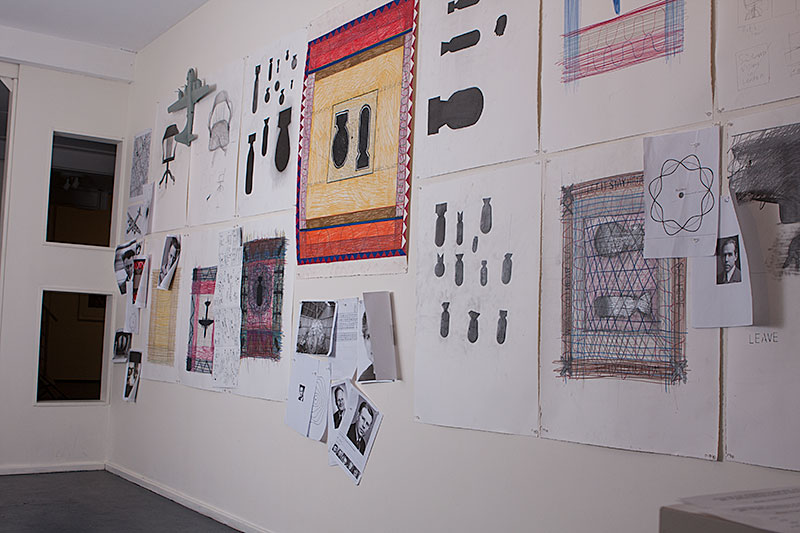
This series of works is about the physicists and the experiments in development of the atomic bomb. It is centred on Oppenheimer’s Chair, which is an exhibit at the Bradbury Science Museum of the Los Alamos National Laboratory. I visited the site in 2015 while touring parts of the USA.
The artwork includes a series of multi-plate etchings, a hand-woven saddle rug and a carved replica of Oppenheimer’s Chair, and other objects, drawings and images.
The development, testing and deployment of the atomic bomb was an astounding technical achievement as well as the great moral dilemma of the Second World War. The physicists who participated in the development were primary concerned with beating the Nazi scientists to the development of the bomb. They were party to the creation of the most destructive weapon known to humankind and were a central pivot in the history of the 20th century.
The physicists, while technically and mathematically supreme, were also creative and playful and the development of physics was one of imagination, speculation and intuition. The bomb development at Los Alamos employed an intense engagement between the theoretical and experimental physicists and specialist military engineers.
Imagine minds like these now offered the resources to solve the problems of the 21st century, by peaceful means.
Oppenheimer’s Chair is an oversize hand carved replica of the office chair in the Bradbury Science Museum of the Los Alamos National Laboratory.
The saddle rug is woven by the artist using a Navajo style loom. The imagery refers to the scientific data, signals and bombs developed at the lab. A saddle rug is often a playful and decorative form of weaving. It is the Pueblo and Navajo people on whose land the Los Alamos work and testing was done and they have a long tradition of weaving.
The etchings explore imagery around the development of the atomic bomb. They include a table of Elements incorporating the slogan of secrecy demanded at the lab. The irony being that the scientists desired openness (there are no secrets in the physics of the universe) yet the military required secrecy for the work on the bomb.
Great ideas came as revelations to physicists. Leo Szilard was prompted by an account of the atomic structure given by Rutherford in a London newspaper (and a statement about the impossibility of splitting the atom) to imagine the chain reaction of a nucleus. This occurred on a street corner in Bloomsbury. He then pursued the possibility relentlessly.
The first controlled chain reaction with uranium was conducted in Chicago by Enrico Fermi. It involved constructing and enormous stack of blocks of pure graphite which contained refined uranium within the blocks. The experiment was conducted in a squash court under a football stadium.
Scientists took many risks with the new materials they developed. An experiment called ‘ticking the dragon’s tail’ involved briefly bringing together a critical mass of refined uranium or plutonium together to measure the reaction. The reaction would be immediately shut down, but enough time would elapse to allow a measurement of the predicted reaction. Two physicists died when they accidently brought together to much material and were exposed to fatal doses of radioactivity.
Many of the physicists, while mindful of the need to make an atomic weapon before the Nazis did, were very pessimistic about the outcome of its use and the future of an arms race with atomic weapons. The cold war was predicted very early. Oppenheimer was an advocate for openness about the bomb in an attempt to stop a cold war and heightened militarism. They were also dismayed at the strategic use of two atomic bombs on Japan, thinking that a demonstration of the weapon’s power nearby would be enough to bring about surrender. This was not the military attitude as history attests.
My own fascination with the subject was started at the Bradbury Science Museum of the Los Alamos National Laboratory, mostly prompted by Oppenheimer’s chair. I found the exhibit bizarre in the context and wondered on the importance of it in amoungst the historical letters (Einstein to Roosevelt) and the documentation and artifacts of the atomic development.
Key texts for those interested in the above that I have referred to include “Inside the Centre, The life of J. Robert Oppenheimer” by Ray Monk (which makes no reference to his chair as I recall) and “The Making of the Atomic Bomb” by Richard Rhodes, and extraordinary tale. A fine collection of saddle rugs is displayed in “Saddle Up! – Navajo small fancy and Sunday Saddle Blankets of the 19th and 20th Centuries” by Mark Winter. This exhibition was at the Toadlena Trading post, which displays and sells Navajo weavings and other general supplies in western New Mexico. Toadlena and Two Grey Hills are renowned Navajo weaving centres. http://weavinginbeauty.com demonstrates techniques and teaching of Navajo weaving and is a fine place to start.